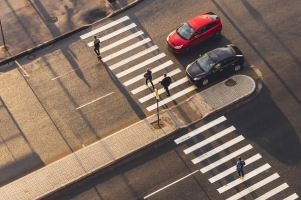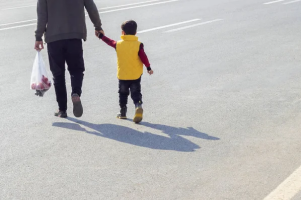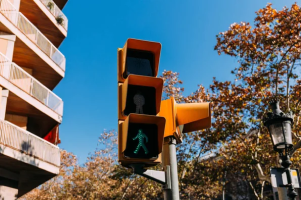
As gasoline prices fluctuate and cities build more infrastructure for pedestrians and cyclists, more people are walking or biking for work, school, and leisure than ever before.
Unfortunately, this also means an increase in accidents involving pedestrians when they are walking somewhere or trying to cross the street.
Below, we go over some of the basic laws that apply to pedestrians and drivers in Utah and what you can do if you or a loved one were a pedestrian involved in an accident while crossing the roadway or using a crosswalk.
Table of Contents
If you or a family member were struck by a vehicle while crossing the street or when walking at an intersection, our Utah pedestrian accident lawyer could help.
You may be eligible to receive compensation for medical expenses, lost wages, and other substantial damages you incurred due to a pedestrian accident caused by a negligent driver.
Here are some examples of possible pedestrian accidents:
In Utah, there are many cases where both a pedestrian and the driver of the other vehicle share responsibility for the accident, especially when a pedestrian fails to use a functioning crosswalk.
Compared to other states with stricter laws on motorists than pedestrians, Utah balances the responsibility more equally between the two. Here’s a quick look at the laws for drivers:

Motorists have the right of way until pedestrians are in a marked crosswalk on the same half of the roadway or the opposite half but close enough to traffic to cause an immediate hazard.
This means that drivers must yield to the pedestrian’s right of way and come to a complete stop when people are walking anywhere in a crosswalk besidesthe far end of the crossing.
The exception to this is school crosswalks. If there is anyone walking anywhere within the crosswalk, even if they are located at the far end, away from any vehicle approaching.

Drivers also may not go around or try to pass a vehicle that is stopped for pedestrians in a marked or unmarked crosswalk. Both vehicles must yield the right of way of the people crossing the street using a designated crossing.
Not only do drivers have certain responsibilities when it comes to navigating intersections where there is a pedestrian crossing, but pedestrians also have laws they must follow when walking on the roadway.
This includes but is not limited to:
Pedestrians are also prohibited from walking or running into traffic, creating an immediate hazard to nearby motorists. And while not mandatory, it’s advised that pedestrians use the left side of the roadway to see oncoming traffic.
There are also crosswalk-specific laws that pedestrians must abide by, like:
As mentioned above, it’s mandatory for pedestrians to use sidewalks, crosswalks, and pedestrian bridges where available in Utah. If there’s a crosswalk that can be safely used and a pedestrian chooses not to, they could be charged with jaywalking.

Jaywalking is a common albeit technically illegal activity that most pedestrians occasionally engage in. Here are a few things to know and how to avoid being charged.
Jaywalking is when a pedestrian crosses the roadway somewhere other than a designated crosswalk, disregarding any potential vehicle approaching.
For example, if a pedestrian crosses an intersection because it looks clear both ways before the signal is given for them to walk, this would be considered jaywalking.
Although charges for jaywalking are uncommon, there may be situations in which law enforcement feels it necessary to cite a citizen for failure to use the appropriate crosswalks or pedestrian bridges.
If charged with jaywalking, citizens could be penalized with a $750 fine or 75 hours of community service.
Salt Lake City is stricter on jaywalking than most jurisdictions and has its own set of laws similar to state statutes regarding when and where pedestrians are legally allowed to cross the street.
It’s important to note that jaywalking laws only apply when designated crosswalks are available for pedestrians to cross the roadway.
If no crosswalk can be used, it’s up to the pedestrian to yield the right of way to motorists and cross when no cars are coming.

Now that you have an idea of the basic laws that everyone using a public roadway must abide by, it’s important to understand how traffic signals are used by pedestrians when crossing the street. Here’s what to know.
Both drivers and pedestrians have a duty to obey traffic control signals at an intersection.
For example, drivers must come to a complete stop at a red light, while pedestrians are prohibited from trying to cross when there’s a vehicle approaching.
At any intersection in Salt Lake City and the rest of Utah state, pedestrians may only cross in front of a stopped vehicle when traffic control signals display the “walk” sign.
This is also the safest bet — even when all the cars are stopped, and it seems okay to cross, it’s impossible to know what the signals on the opposite half of the road are telling drivers to do.
As mentioned above, special signals are used at intersections to direct pedestrians when and where to walk.
They are common in metropolitan locations like Salt Lake City, with more people walking from place to place than in smaller rural areas.
A pedestrian can request to cross at an intersection by pushing a button on the signal pole labeled with the direction they want to walk.
Then, the signal will flash along with the time the pedestrian has to make it through the crosswalk.
Both pedestrians and vehicle drivers can receive citations for violating pedestrian safety laws depending on the circumstances of the situation.
Here are just a few examples of legal violations either a driver or pedestrian could be charged with and the penalties for each:
Even though you have the right of way in a crosswalk, it can be nerve-wracking to actually take that first step in front of a stopped vehicle.
Here are some helpful pedestrian safety tips to use next time you’re walking alongside traffic or going through a pedestrian crossing:

Get legal help after an accident caused by a driver violating your right of way when they were required to yield to pedestrians. You may be eligible for compensation.
Contact the veteran Salt Lake City personal injury lawyers at Parker & McConkie today for a free initial consultation to discuss your pedestrian accident case by calling (801) 980-9708.



